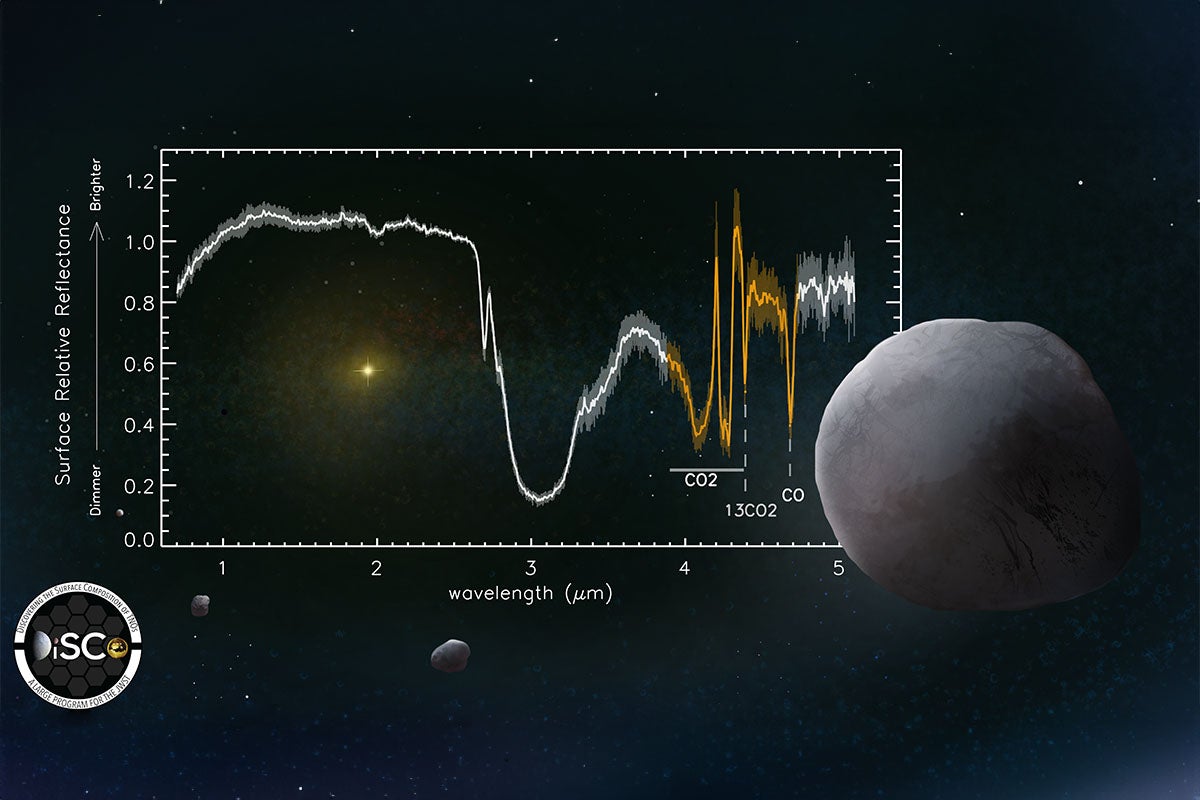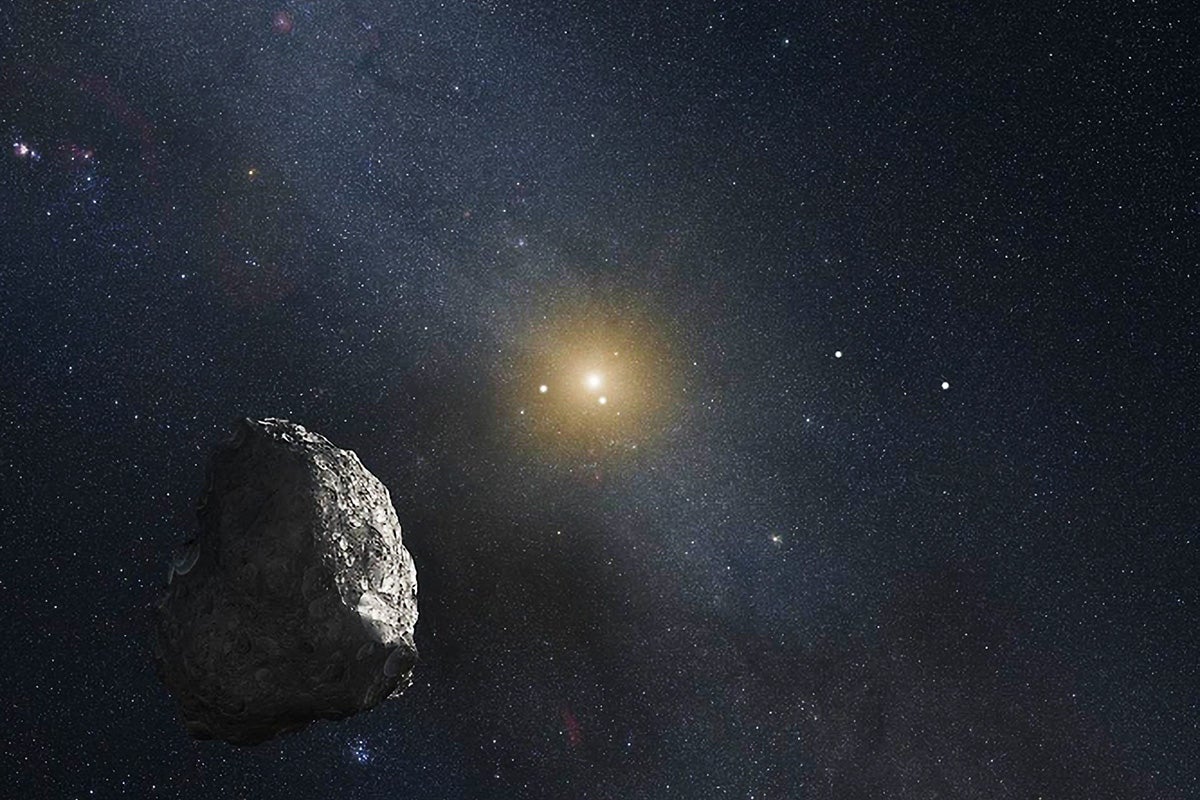For the first time, carbon dioxide and carbon monoxide ices have been observed in the far reaches of our solar system on trans-Neptunian objects (TNOs).
A research team, led by planetary scientists Mário Nascimento De Prá and Noemí Pinilla-Alonso from the University of Central Florida’s Florida Space Institute (FSI), made the findings by using the infrared spectral capabilities of the James Webb Space Telescope (JWST) to analyze the chemical composition of 59 trans-Neptunian objects and Centaurs.
The pioneering study, published this week in Nature Astronomy, suggests that carbon dioxide ice was abundant in the cold outer regions of the protoplanetary disk, the vast rotating disk of gas and dust from which the solar system formed. Further investigation is needed to understand the carbon monoxide ice’s origins, as it also prevalent on the TNOs in the study.
The researchers reported the detection of carbon dioxide in 56 TNOs and carbon monoxide in 28 (plus six with dubious or marginal detections), out of a sample of 59 objects observed with the JWST. Carbon dioxide was widespread on the surfaces of the trans-Neptunian population, independent of the dynamical class and body size while carbon monoxide was detected only in objects with a high carbon dioxide abundance, according to the study.
The work is part of the UCF-led Discovering the Surface Compositions of Trans-Neptunian Objects program (DiSCo-TNOs), one of the JWST programs focused on analyzing our solar system.

“It is the first time we observed this region of the spectrum for a large collection of TNOs, so in a sense, everything we saw was exciting and unique,” says de Prá, who co-authored the study. “We did not expect to find that carbon dioxide was so ubiquitous in the TNO region, and even less that carbon monoxide was present in so many TNOs.”
The discovery of the ices can further help us understand the formation of our solar system and how celestial objects may have migrated, he says.
“Trans-Neptunian Objects are relics from the process of planetary formation,” de Prá says. “These findings can impose important constraints about where these objects were formed, how they reached the region they inhabit nowadays, and how their surfaces evolved since their formation. Because they formed at greater distances to the Sun and are smaller than the planets, they contain the pristine information about the original composition of the protoplanetary disk.”
Chronicling Ancient Ice
Carbon monoxide ice was observed on Pluto by the New Horizons probe, but not until JWST was there an observatory powerful enough to pinpoint and detect traces of carbon monoxide ice or carbon dioxide ice on the largest population of TNOs.
Carbon dioxide is commonly found in many objects in our solar system. So, the DiSCo team was curious to see if it existed in greater quantities beyond the reaches of Neptune.
Possible reasons for the lack of previous detections of carbon dioxide ice on TNOs include a lower abundance, non-volatile carbon dioxide becoming buried under layers of other less volatile ices and refractory material over time, conversion into other molecules through irradiation, and simple observational limitations, according to the study.
The discovery of carbon dioxide and carbon monoxide on the TNOs provides some context while also raising many questions, de Prá says.
“While the carbon dioxide was probably accreted from the protoplanetary disk, the origin of the carbon monoxide is more uncertain,” he says. “The latter is a volatile ice even in the cold surfaces of the TNOs. We can’t rule out the carbon monoxide was primordially accreted and somehow was retained until present date. However, the data suggests that it could be produced by the irradiation from carbon-bearing ices.”
An Avalanche of Answers
Confirming the presence of carbon dioxide and carbon monoxide on TNOs opens many opportunities to further study and quantify how or why it is present, says Pinilla-Alonso, who also co-authored the study and leads the DiSCo-TNOs program.
“The discovery of carbon dioxide on trans-Neptunian objects was thrilling, but even more fascinating were its characteristics,” she says. “The spectral imprint of carbon dioxide revealed two distinct surface compositions within our sample. In some TNOs, carbon dioxide is mixed with other materials like methanol, water ice, and silicates. However, in another group — where carbon dioxide and carbon monoxide are major surface components — the spectral signature was strikingly unique. This stark carbon dioxide imprint is unlike anything observed on other solar system bodies or even replicated in laboratory settings.”
It now seems clear that when carbon dioxide is abundant, it appears isolated from other materials, but this alone doesn’t explain the band shape, Pinilla-Alonso says. Understanding these carbon dioxide bands is another mystery, likely tied to their unique optical properties and how they reflect or absorb specific colors of light, she says.
It was commonly theorized that perhaps carbon dioxide may be present in TNOs as carbon dioxide exists in a gaseous state in comets, which are comparable in composition, Pinilla-Alonso says.
“In comets, we observe carbon dioxide as a gas, released from the sublimation of ices on or just below the surface,” she says. “However, since carbon dioxide had never been observed on the surface of TNOs, the common belief was that it was trapped beneath the surface. Our latest findings upend this notion. We now know that carbon dioxide is not only present on the surface of TNOs but is also more common than water ice, which we previously thought was the most abundant surface material. This revelation dramatically changes our understanding of the composition of TNOs and suggests that the processes affecting their surfaces are more complex than we realized.”
Thawing the Data
Study co-authors Elsa Hénault, a doctoral student at the Université Paris-Saclay’s Institut d’Astrophysique Spatiale, and French National Center of Scientific Research, and Rosario Brunetto, Hénault’s supervisor, brought a laboratory and chemical perspective into the interpretation of JWST observations.
Hénault analyzed and compared the absorption bands of carbon dioxide and carbon monoxide across all objects. While there was ample evidence of the ice, there was a great diversity in abundance and distribution, Hénault says.
“While we found CO2 to be ubiquitous across TNOs, it is definitely not uniformly distributed,” she says. “Some objects are poor in carbon dioxide while others are very rich in carbon dioxide and show carbon monoxide. Some objects display pure carbon dioxide while others have it mixed with other compounds. Linking the characteristics of carbon dioxide to orbital and physical parameters allowed us to conclude that carbon dioxide variations are likely representative of the objects’ different formation regions and early evolution.”
Through analysis, it is very likely that carbon dioxide was present in the protoplanetary disk, however, carbon monoxide is unlikely to be primordial, Hénault says.
“Carbon monoxide could be efficiently formed by the constant ion bombardment coming from our sun or other sources,” she says. “We are currently exploring this hypothesis by comparing the observations with ion irradiation experiments that can reproduce the freezing and ionizing conditions of TNO surfaces.”
The research brought some definite answers to longstanding questions dating back to the discovery of TNOs nearly 30 years ago, but researchers still have a long way to go, Hénault says.
“Other questions are now raised,” she says. “Notably, considering the origin and evolution of the carbon monoxide. The observations across the complete spectral range are so rich that they will definitely keep scientists busy for years to come.”
Although the DiSCo program observations are nearing a conclusion, the analysis and discussion of the results still have a long way to go. The foundational knowledge gained from the study will prove to be an important supplement for future planetary science and astronomy research, de Prá says.
“We have only scratched the surface of what these objects are made of and how they came to be,” he says. “We now need to understand the relationship between these ices with the other compounds present in their surfaces and understand the interplay between their formation scenario, dynamical evolution, volatile retention and irradiation mechanisms throughout the history of the solar system.”
Team Effort
Study co-authors also included Ana Carolina de Souza Feliciano, Charles Schambeau, Yvonne Pendelton, Dale Cruikshank and Brittany Harvison with UCF; Bryan Holler and John Stansberry with the Space Telescope Science Institute; Jorge Carvano with the Observatorio Nacional do Rio de Janeiro in Brazil; Javier Licandro and Vania Lorenzi with the Instituto de Astrofísica de Canarias in Spain; Thomas Müller with the Max-Planck-Institut für extraterrestrische Physik in Germany; Nuno Peixinho with the Instituto de Astrofísica e Ciencias do Espaço in Portugal; Aurélie Guilbert-Lepoutre with the Laboratoire de Géologie de Lyon in France; Michele Bannister with the University of Canterbury in New Zealand; and Joshua Emery and Lucas McClure with Northern Arizona University.
Researchers’ Credentials:
De Prá joined UCF FSI in 2022 as an assistant scientist. He previously spent nearly four years as a preeminent postdoctoral associate at FSI. De Prá received his doctorate in astronomy in 2017 at the Observatório Nacional do Rio de Janeiro, Brazil. He works with observational planetary sciences using several ground and space-based telescopes to study the connection between different small body populations.
Pinilla-Alonso is a professor at FSI and joined in 2015. She received her doctorate in astrophysics and planetary sciences from the Universidad de La Laguna in Spain. Pinilla-Alonso also holds a joint appointment as a professor in UCF’s Department of Physics and has led numerous international observational campaigns in support of NASA missions such as New Horizons, OSIRIS-REx and Lucy.




